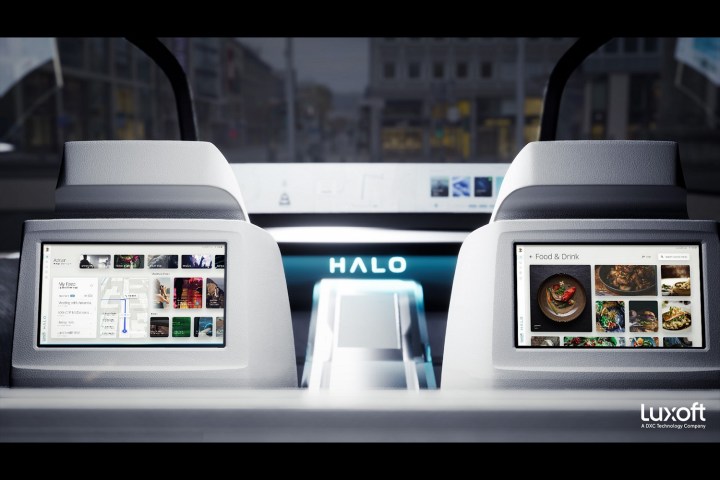
Swiss firm Luxoft announced an in-car connectivity platform named Halo developed for ride-hailing and commuting. It’s based on LG’s WebOS operating system, and it leverages technology provided by big names like Amazon and MapBox.
Halo aims to seamlessly integrate the apps and digital services we use on a daily basis into a personalized platform that follows commuters into the car. If you take an Uber to the airport, for example, you’ll currently need to rely on your phone, your tablet, or your laptop to access the music you like to stream, your agenda, or traffic information. Luxoft bundles these features into an on-demand infotainment system that tailors its content to each occupant, and displays the content in the cabin.
The interface presents information on color tiles, and it ideally needs a rear-seat entertainment system to display it on. Once passengers are settled into the rear seats, they only need to identify themselves via a one-step identification process (by scanning a QR code, for example) to enter their digital world. Halo suggests movies, television shows, news stories, and albums; it displays navigation information about the current trip; and it shows the user’s agenda. It also suggests restaurants and points of interests, provides real-time weather information, and has a karaoke menu. The back of an Uber becomes a mobile office, a living room on wheels, a night club, or all three during the same trip.

Halo is fully customizable, so it can gain or lose features depending on the application it’s needed for. Luxoft told Digital Trends it envisions a more basic version that provides local sights, weather information, and, significantly, context-aware deals and ads. You might see a coupon for Taco Time pop up on the screen when you ride past one. It can also help ride-hailing drivers stay organized by letting them sign into different platforms (like Uber, Lyft, etc) via a single account.
Amazon’s Alexa voice recognition technology allows users to access Halo’s different functions. It’s an active version of the software, Luxoft claimed, so Alexa automatically checks sources like MapBox to detect when traffic is dense, for example, and speaks up without being called on to suggest an alternative route, rather than waiting for the driver to ask for help.
Luxoft’s Halo platform will make its debut at CES 2020. It’s ready for production, but there’s no word yet on when it will hit the market.
Editors' Recommendations
- Harman brings live concerts to your car’s headrest
- Elliptic Labs gesture controls and presence detection coming to your living room
- Luminook is a smart light designed to better illuminate your closet
- LG not only wants to keep your leafy greens fresh, but help you grow them too
- Plex will add subscription channels to its platform this year




